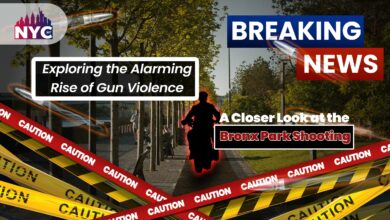5 Places for the Best Pizza in NYC: A Guide to the City’s Top Slice of Pie
Best Pizza Pie in the Town
The first pizza pies in America were created in New York City. In New York City, even the birds have their preferred slices. For the finest experiences for the best pizza in nyc, you can go to both old and new classics. Equally important is the question of which locations today serve the best pizza pie is one that can be debated in depth.
Pizza preferences have been and will continue to be highly subjective. Moreover, the variety includes, for instance, dough blocks made in the Detroit manner and delicate, olive oil-slick Roman pizzas. For instance, you might never want to go to New Jersey to eat pizza. However, we can base our ranking as the sequence of restaurants someone would go to first if all of these pizzas were accessible to dine in a single American city.
In addition, given the size and diversity of the New York City, restaurants are known for serving some of the world’s most renowned pizza. Moreover, these restaurants allow one to create their very own pizza of their taste. Hence, the customers can add ingredients of their choice like black olives, or one might like to choose one of the delicacies like the “clam pie”. What’s more? You can add olive oil, fresh garlic, herbs, and “sprinkle of grated cheese or can topple the thin crunchy crust with sausage, patties, peppers, onions, olives and mushrooms. Here are our top five pizza places. Some have been around since decades and some are quite new. They’re all amazing.
Top 5 Best Pizza huts in New York City
1- Bleecker Street Pizza
Bleecker Street Pizza’s pizza pie is shockingly thin, while it also manages to be tough and sturdy, able to be bearing various toppings as well as touches. Hence we find the reason that ranks the Bleecker Street Pizza, the best in New York City. You’ll be assaulted with a rush of freshly produced, somewhat sweetened tomato sauce and best tasting caramelized cheese when the dough breaks.
Nona Maria Pie, a traditional family dish, is special at the Bleecker Street Pizza. Besides, this contains delectable thin-crust pizza that is topped with handmade garlic sauce, fresh basil, finest mozzarella, and the best parmesan. In addition, they constantly provide delicious and delectable dishes, which include gluten free pizzas, calzones, salad, pasta, and more, with ample quantities and incomparable flavors! Beer and wine are available at Bleecker Street Pizza.
Many of the visitors at Bleecker Street Pizza vouch for simple pizza pie which includes just cheese and tomatoes. Others will be tempted to devour the well-known vodka pizza pie in which the sauce is filled with vodka and cream, too. But some people will be adamant about trying each one as it all tastes the best. You must visit to experience a bite of best pizza in NYC.
Details to reach out to Bleecker Street Pizza:
Phone number: +1 212-924-4466
Address: 69 7th Ave S at Bleecker Street Pizza, New York City, NY 10014-4043
Opening hours: 10:00 AM – 05:00 AM
Website: https://bleeckerstreetpizza.com/
2- Famous Amadeus Pizza
In the 1980s, Amadeus travels to America. He launches his first pizzeria in Hell’s Kitche, New York, and hasn’t departed the neighborhood since.
Famous Amadeus Pizza bakes delicious pizzas each day. Moreover, a lot of effort is into providing you with the pizza you crave at odd hours. Moreover, all of the pizzas chefs have more years of experience than one can possibly count on both fingers, preparing the best pizza pie one adores.
Besides, one will be greeted with a rush of freshly produced, sweet tomato sauce and caramelized cheese as the dough breaks. In addition, the visitors vouch for simple pie which contains just cheese and tomatoes only. You can have a pizza whenever you want because they are open seven days a week, fairly late.
Details to reach out to Famous Amadeus Pizza:
Address: 840 8th Ave btw 50th St. & 51st St., New York City, NY 10019-6647
Website: https://www.famousamadeus.com/
Opening hours: 09:00 AM – 03:00 AM
Contact number: +1 212-489-6187
3- NY Pizza Suprema
The restaurant, NY Pizza Suprema offers Fast Food, Pizzas of numerous varieties, and Italian cuisine. NY Pizza Suprema caters to both vegetarians and those who are not vegans. It is situated in New York City, at 413 8th Avenue between 31st and 30th Street. Teenagers and a whole lot of others pile up at the counter of NY Pizza Suprema for the best pizza pie experience.
What’s more? The pizza is loaded with basil, cheese, and tomato sauce on thick dough. Each incredibly weightless chunk will deliver a pleasant crackling as you bite in to swallow it. In addition, the dough is particularly savory as well as crunchy. Besides, the pizza is thick and square, with a crispy bottom and a substantial amount of mushy, spongy, somewhat undercooked dough in the centre.
Moreover, Tomato sauce, cream cheese, as well as more tomato sauce is all added to the top to create a shockingly hefty, gooey pizza that is worth walking multiple miles across town for. Moreover, there is enough stuff on each slice without adding toppings.
You’ll be ecstatic after taking the first mouthful. NY Pizza Suprema also provides its customers with nubby, buttery, garlicky nibbles known as garlic knots. It is opposite the Madison Square. Lastly, the best news is that the restaurant delivers for no charge!
Details to reach out to NY Pizza Suprema:
Address: 413 8th Ave, New York City, NY 10001-1804, Midtown 0.5 miles from Empire State Building
Opening hours: 10:30 AM – 12:00 AM
Website: http://www.nypizzasuprema.com/
Contact number: +1 212-594-8939
4- Paulie Gee’s Slice Shop
Paulie Gee’s Slice Shop is the favorite spot of many. From the simple cheese pizza pie to their trademark Hellboy, the pizza is superb. Additionally, Paulie Gee’s Slice produced delicious vegan pizza through both square and circular shapes. Besides, they have the best caramelized pizzas, toppled with juicy meatballs. Thin and thick crusts are both available for the customers.
With this, customers are also permitted to design their own pizzas with topping of their choice. Moreover, Basil and tomato sauce are sprinkled throughout the pizza dough. As you bite into the light chunk, you’ll hear a satisfying crackling.
The dough is especially crisp and salty. Their pizza has crispy bottom and a substantially undercooked crust in the centre. Tomato sauce, cream cheese, as well as more tomato sauce is all added to the top to create a shockingly dense, pizza.
Significantly, one may purchase this in low prices. Furthermore, as you take in the pizza pie, you can linger out and sip wine or beer in the little area provided. Their delivery is also available. Lastly, Paulie Gee’s Slice Shop also provides with canned beers. Hence, relish the best pizza in NYC at Paulie Gee’s Slice Shop.
Details to reach out to Paulie Gee’s Slice Shop:
Address: 110 Franklin St, Brooklyn, NY 11222, United States
Opening Hours: Closes 10PM
Contact number: +1 929-337-6385
Website: https://pauliegee.com/slice-shop/
5- SottoCasa Pizzeria
SottoCasa Pizzeria is owned by an old couple, preparing the best pizzas all by themselves. The operators of the Sottocasa restaurant in Brooklyn’s Boreum Hill are Luca and Mariarosa. Trendy, tasty, authentic Italian pizza, using the best ingredients and a century-old method all the while keeping a close eye on the healthy environment, are served. Besides, the finest flour and tomatoes used in the pizzas come from Italy. They are kept as fresh as possible.
Basil, mozzarella, and tomato sauce are sprinkled throughout the creamy pizza crust. As you bite in to swallow each exceedingly light chunk, you’ll hear a satisfying crackling. Besides, the dough is especially crisp and flavorful. In addition, both goat and Italian cheese are offered to the customers. SottoCasa Pizzeria’s pizzas have a delicious combination of mixed greens, cherry tomatoes, roasted beet dressing, olives, arugula salad, and spinach as their toppings.
Details to reach out to SottoCasa Pizzeria:
Address: 227 Lenox Ave, New York City, NY 10027-6542
Website: https://sottocasanyc.com/
Opening hours: 5:00 PM – 10:00 PM
Contact number: +1 646-928-4870
End Note: Stay Tuned with the flavored and tasteful pizzas around NYC
In the final assessment, the finest and insanely yummy pizza serving huts as well as restaurants can be found in New York City with much ease. Moreover, they give the customers best experience not only in taste but also with the best serving and environment. In addition, these pizza pie places remain competitive with other states of America in every way. They provide with large variety of pizzas.
Olives, meatballs, basil, mozzarella, and tomato sauce are all of the best quality and served in the finest manner in these restaurants. Moreover, the pizza dough and crust are very creamy and easy to bite into. As you bite in to swallow each exceedingly light chunk, you’ll hear a satisfying crackling. Additionally, the dough is especially crisp and flavorful.
The pizzas from these top and best places have a crispy bottom and an undercooked crust in the centre. Besides, Tomato sauce, cream cheese and tomato sauce are all added to the top to create a shockingly thick pizza. Hence, for the best experience and best pizza in NYC one must be visiting these pizza places in New York City.



